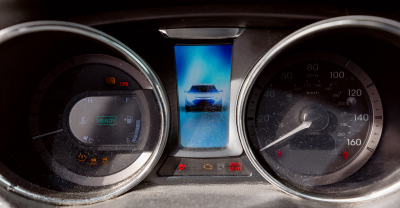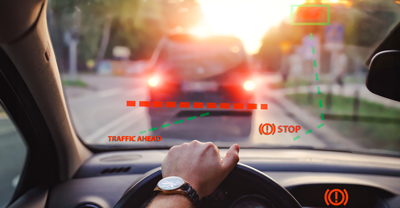How to identify car dashboard symbols


0 min. read
You may not be a car maintenance expert, but that doesn’t mean you can’t be in tune with your vehicle. Since you drive your car more than anyone else, you know its quirks—but when should a car dashboard symbol prompt you to act or ask a professional for help? Explore Dairyland’s cheap car insurance options to find the coverage that fits your lifestyle and budget.
Use this guide to quickly understand the most common dashboard warning lights, help maintain your vehicle’s safety, and prevent small issues from becoming expensive repairs. If you see a warning light you can’t identify, check your car’s manual—it has the most comprehensive information about your car dashboard symbols.
Check engine light

Generally shaped like the outline of an engine block, the check engine light is likely one of the most misunderstood car dashboard symbols. Ignoring this light can lead to further damage and potential safety hazards. It doesn’t always mean a serious issue—but pay attention when you see it.
What it could mean:
Loose gas cap
Low-quality or contaminated gas
Malfunctioning oxygen sensor
Worn spark plugs, wires, or ignition coils
Failing catalytic converter
Overheating engine or serious internal damage
What to do:
If the light is steady, drive cautiously but observe how your car’s performing and schedule an appointment as soon as possible.
If the light is flashing, safely reduce your speed and pull over immediately. Turn off the engine and call for a tow truck to get your vehicle to a service station.
Look for other warning indicators like leaking fluid, odd noises, smoke or steam from the engine compartment, and changes in performance.
A technician will likely connect to your car’s onboard computer (OBC) and read any error codes it’s giving off. This information can assist a service shop in pinpointing the issue and repairing it.
Battery warning

It’s normal for the battery symbol—a rectangle with positive (+) and negative (-) terminals—to pop on when you first start your car, or when it’s in auxiliary mode. However, if the light stays on while driving, it could mean an issue with your car’s charging system, which could prevent your car from starting or cause it to stall while running.
What it could mean:
Loose or corroded terminal connections
Faulty alternator or serpentine belt
Worn-out battery
What to do:
If your car is running normally, a certified mechanic or auto parts store can test your battery with a multimeter to determine if the problem is the battery or the alternator.
On average, car batteries last three to four years, but can last six or more in ideal conditions. It may be time to replace your battery.
If your car doesn’t start, try a jump start from another vehicle or a portable battery booster.
Coolant temperature warning

This symbol—a thermometer floating in water—indicates your engine is overheating and requires immediate action.
What it could mean:
Low coolant levels
Coolant leak
Faulty water pump, radiator, cooling fan, or thermostat
What to do:
Safely pull over and turn off the engine as soon as possible.
Open the hood and allow the engine to cool for at least 30 minutes.
Don’t attempt to open the radiator cap while the engine is hot. Pressurized hot coolant can spray out and cause severe burns.
If the coolant level is low, carefully refill the reservoir with appropriate coolant for your vehicle.
If the warning light comes back on after adding coolant, or you notice other signs of overheating—like steam or unusual smells—don’t drive the vehicle.
If drivable, take your vehicle to a mechanic for diagnosis and repair.
Oil pressure warning

A symbol that looks like an oil can with a drop of fluid coming out of the spout indicates low engine oil pressure. This is a critical warning that requires immediate action.
What it could mean:
Low oil levels
Wrong viscosity or contaminated oil
Clogged oil filter
Faulty oil pump
Internal engine damage
What to do:
If you’re driving, pull over as soon as it’s safely possible and shut the engine off.
Check the oil level, and if it’s low, top it off. Use the same weight motor oil that's already in your car and meets the manufacturer’s specifications. It can be helpful to keep a quart or two of the correct oil in your trunk for emergencies.
If you’re over the recommended time or miles between oil changes, prioritize taking it to a service station or changing the oil yourself.
If your oil is at the correct level or you can’t refill it, don’t start the engine. Call a tow truck to avoid causing engine damage by driving it.
Have a certified mechanic diagnose and repair the problem.

Exclamation point car dashboard symbols

The general warning light for most vehicles is an exclamation point inside a triangle. Several dashboard symbols use an exclamation point inside different shapes. Here’s what they mean:
Lamp out
You're often unaware if one of your car's running lights isn't working. This indicator helps keep you and other drivers safe on the road.
What it could mean:
Burned out bulb in headlights, taillights, brake lights, or turn signals
Faulty wiring in light assembly
What to do:
Check all lights for burned out bulbs.
Replace any burned out bulbs.
If all bulbs are working, or if changing the bulb doesn’t fix the problem, have a mechanic test the wiring.
Low tire pressure
Driving on over- or underinflated tires is dangerous and can lead to blow outs. Monitor your tire pressure regularly.
What it could mean:
Low tire pressure
Slow leak
Malfunctioning tire pressure monitor
What to do:
Find the recommended PSI in your owner’s manual, on a sticker inside the driver’s side door jam, or—on some newer vehicles—the warning itself will suggest the ideal tire pressure.
Using an air pressure gauge, check the pressure of each tire.
If the pressure is low, add air to each tire until it reaches the recommended PSI.
After filling the tires, recheck the pressure after a short drive.
If the tire loses pressure rapidly, or the light comes back on, you likely have a leak.
If you can't add air, or suspect a leak, take your vehicle to a qualified mechanic.
Brake system warning
An exclamation point, or the letters ABS—for anti-lock brake system—inside a circle that has parentheses around it indicates a critical issue with the vehicle’s braking system. This is a serious safety hazard.
What it could mean:
Brake fluid leak
Worn or faulty brake pads
Malfunctioning ABS system
What to do:
If the brake warning light illuminates while you’re driving, safely pull over onto the shoulder or into a parking lot to check for leaks.
Don't attempt to drive the vehicle.
Carefully check for any visible brake fluid leaks near the wheels or under the vehicle.
Check the brake fluid reservoir level.
Call for a tow truck to get your car to a service station. A certified mechanic can diagnose and repair the problem.
Always treat this warning light as an emergency.
Transmission temperature warning
An exclamation point inside a gear or cog typically appears on the dashboard when there’s an issue with your car’s transmission or drivetrain. Address this warning immediately to help prevent further damage.
What it could mean:
Overheating transmission
Low transmission fluid
Internal transmission damage
What to do:
Find the transmission fluid dipstick and check the level.
Don't delay service. Drive to a certified service center as soon as possible for diagnosis. Even if the car seems to be driving as usual, continuing to drive with this warning light illuminated can cause severe damage.
If your car exhibits any of the following symptoms: slipping gears, harsh shifting, unusual noises, or jerking, immediately pull over to a safe location and turn off the engine.
Call a tow truck to take your vehicle to a certified service center.
General maintenance warning or powertrain warning

The wrench—like the exclamation point—can have different meanings depending on your vehicle’s manufacturer. This car dashboard symbol often indicates a potentially serious issue.
What it could mean:
Critical mechanical powertrain issues
Faulty sensors in powertrain system
What to do:
Check your owner’s manual to identify the specific meaning of the wrench symbol for your vehicle.

Seat belt indicator

This dashboard symbol—featuring an icon of a person wearing a seatbelt—is often accompanied by a steady beeping or chiming sound.
What it could mean:
One or more people aren’t wearing their seatbelt
Malfunctioning seat belt sensor
Personal belongings in the seat are triggering the sensor
What to do:
Make sure everyone is buckled correctly.
Remove any loose items from the seats, especially heavy objects that could trigger the sensor.
If the light and beeping persist after confirming everyone is buckled and removing items, try turning the vehicle off and back on.
If the problem still occurs, have the seat belt system inspected by a qualified mechanic, as a malfunctioning sensor can interfere with proper airbag deployment.
Airbag warning lights

Airbag warning lights come in a couple of styles. Traditionally, the words AIR BAG or the initials SRS (for supplemental restraint system) would appear in red or yellow on the dashboard. As car dashboard symbols have become more image-based, it shifted to a graphic consisting of a person from the side with their seat belt on and a large circle in front of them. The light indicates a potentially serious safety issue.
What it means:
Malfunctioning airbag system
What to do:
Take your vehicle to a mechanic as soon as possible to have it diagnosed and repaired.
Parking brake

The capital letter P stands for parking and lets you know the status of your parking brake.
What it means:
Parking brake is engaged
What to do:
Disengage the parking brake before attempting to drive the vehicle.
Low fuel

This icon looks like a traditional fuel pump with a hose and is very standardized across vehicles in the U.S.
What it means:
Your vehicle is low on fuel
What to do:
Head to the nearest gas station and refuel your vehicle as soon as possible.
When the low fuel light illuminates, you typically have approximately 1/6 to 1/8 of a tank remaining.
To help you plan your trip to the gas station, make a note of the approximate number of miles your vehicle can travel once the light appears.
Also note the gas pump icon near the bottom of your fuel gauge. The arrow next to it indicates which side of your vehicle the fuel cap is located on.
Washer fluid low

This symbol often depicts a windshield shape with a dashed or wavy line indicating a spray of fluid.
What it means:
Washer fluid reservoir is almost empty
What to do:
While the car is off, find the reservoir cap clearly marked under the hood and top off washer fluid.
Gas cap light

This car dashboard symbol—sometimes represented as a plug or screw positioned outside the vehicle—tends to appear after you’ve stopped for gas. The gas cap light isn’t standard across all vehicles. Some manufacturers roll this warning into the standard check engine light. That’s because your engine and the onboard computer system that limits emissions don’t function properly without the pressure created by the gas cap.
Driving without a properly sealed gas cap can cause some serious engine damage.
What it could mean:
Loose gas cap
Missing gas cap
Fuel leak
What to do:
Tighten the gas cap.
If it’s missing, immediately purchase a replacement at an auto supply store.
If the warning light stays on after tightening or replacing the gas cap, or if you smell gasoline, don't drive the vehicle.
Have your vehicle inspected by a certified mechanic as soon as possible to check for fuel leaks.
Fog lights

The symbol typically features horizontal lines emitting from a dome, representing a headlight, with a wavy vertical line passing through it, representing fog.
What it means:
Fog lights on your vehicle are active
What to do:
Fog lights are designed to improve visibility in foggy, snowy, or heavy rain conditions.
Some newer vehicles have automatic fog lights that activate when the vehicle senses these conditions.
If the indicator light is on, and you did not manually activate the fog lights, consider the weather conditions and adjust your driving accordingly.
Traction control

A car dashboard symbol that resembles a vehicle with squiggly lines behind it indicates the traction control system (TCS) is actively working to prevent wheel slip. This system works in conjunction with the anti-lock braking system (ABS) to improve vehicle stability and handling, especially in slippery conditions.
What it could mean:
Slippery roads
Faulty wheel speed sensors
ABS system errors
TCS wiring malfunctions
What to do
If the traction control indicator is flashing, it means the TCS is actively working to prevent wheel slip. This is normal during bad weather conditions.
If the traction control indicator remains constantly illuminated, it indicates a potential malfunction in the TCS or related systems. Have your vehicle inspected by a certified mechanic as soon as possible.
If you feel the TCS is not engaging when it should, such as during noticeable wheel slippage in slippery conditions, have your vehicle inspected by a certified mechanic.
Some vehicles allow you to manually turn off the traction control system. Consult your vehicle's owner's manual for instructions.
Blind spot monitor and lane departure warning

Many newer vehicles are equipped with automatic safety features like blind spot monitoring and lane departure warning to enhance driver awareness and help prevent accidents.
What it could mean:
The system detects a vehicle in your blind spot.
The system detects your vehicle unintentionally veering out of its lane and alerts you with a warning.
What to do:
Blind Spot Monitor: If the warning activates, carefully check your mirrors and blind spots before changing lanes. Don’t rely solely on the system; always perform a visual check.
Lane Departure Warning: If the warning activates, gently steer your vehicle back into your lane. The system is designed to alert you to unintentional lane departures, which can indicate driver distraction or fatigue.
These systems can malfunction. If the warning lights for these systems remain illuminated on your dashboard, have your vehicle inspected by a certified mechanic.

The general information in this blog is for informational or entertainment purposes only. View our blog disclaimer.














